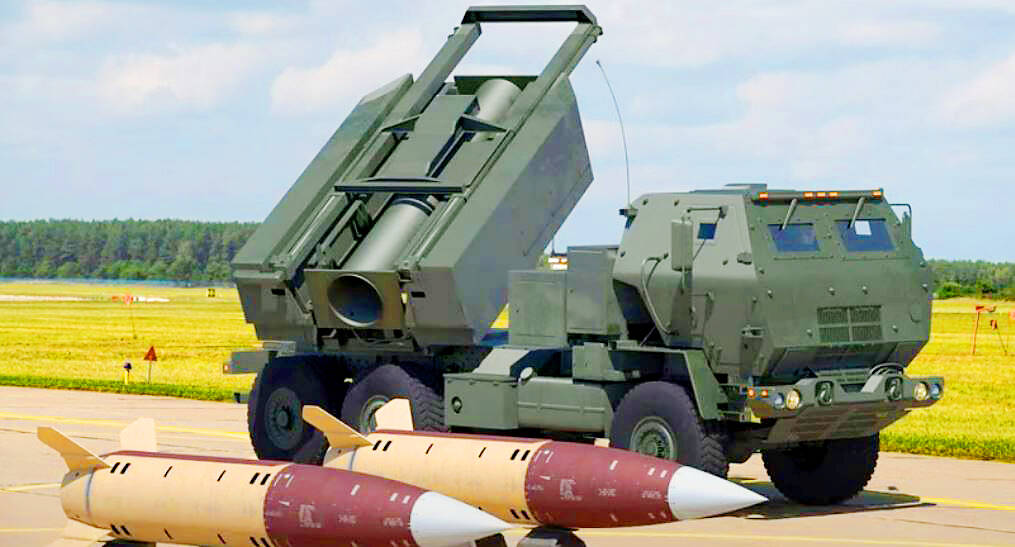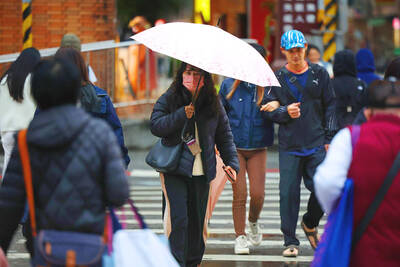The US’ early delivery of long-range tactical ballistic missiles to Taiwan last month carries political and strategic significance, a military source said yesterday.
According to the Ministry of National Defense’s budget report, the batch of military hardware from the US, including 11 sets of M142 High Mobility Artillery Rocket Systems (HIMARS) and 64 MGM-140 Army Tactical Missile Systems, had been scheduled to be delivered to Taiwan between the end of this year and the beginning of next year.
However, the first batch arrived last month, earlier than scheduled, with the second batch —18 sets of HIMARS, 20 MGM-140 missiles and 864 M30 and M31 Guided Multiple Launch Rocket System (GMLRS) rockets — expected to be delivered by 2026.

Photo: Frame grab from Global Defense Corp’s YouTube channel
M30 and M31 GMLRS rockets have an average range of 70km and a maximum range of 94km, while their integrated GPS-aided navigation systems allow them to accurately hit enemy targets.
MGM-140 missiles have a much longer range of up to 300km.
The early delivery of the MGM-140 missiles before the GMLRS rockets indicated a strategic decision to send an international message, said a source from the ministry, who asked to remain anonymous.
Previously, the US would defer the delivery of long-range, high-precision weapons to Taiwan out of concern for cross-strait tensions, even though those arms sales had been approved, the source said.
For example, the delivery of advanced, medium-range, air-to-air missiles — which are compatible with F-16 Fighting Falcon combat aircraft — was not completed and remained on hold in Guam until Taiwan developed indigenous medium-range air-to-air missiles of the same level — the advanced Tien Chien II (Sky Sword II) missiles, the source said.
The early delivery of long-range MGM-140 missiles reflected the US’ strategy to counter Chinese coercion by helping Taiwan to bolster its capacity to strike targets within China’s national borders, they said.
The MGM-140 missiles could be launched across the Taiwan Strait to attack critical airports and military bases in China if Beijing initiates a military assault against Taiwan, the source said.
Since the Third Taiwan Strait Crisis in 1995 and 1996, Taiwan has developed indigenous ballistic missiles with ranges long enough to reach China’s coastal and inland military bases, although their number and accuracy have yet to be released to the public, the source said.
The indigenous Hsiung Feng IIE (HF-IIE, “Brave Woid 11E”) and extended-range HF-IIE cruise missiles have yet to be disclosed either, the source added.

US climber Alex Honnold is to attempt to scale Taipei 101 without a rope and harness in a live Netflix special on Jan. 24, the streaming platform announced on Wednesday. Accounting for the time difference, the two-hour broadcast of Honnold’s climb, called Skyscraper Live, is to air on Jan. 23 in the US, Netflix said in a statement. Honnold, 40, was the first person ever to free solo climb the 900m El Capitan rock formation in Yosemite National Park — a feat that was recorded and later made into the 2018 documentary film Free Solo. Netflix previewed Skyscraper Live in October, after videos

Starting on Jan. 1, YouBike riders must have insurance to use the service, and a six-month trial of NT$5 coupons under certain conditions would be implemented to balance bike shortages, a joint statement from transportation departments across Taipei, New Taipei City and Taoyuan announced yesterday. The rental bike system operator said that coupons would be offered to riders to rent bikes from full stations, for riders who take out an electric-assisted bike from a full station, and for riders who return a bike to an empty station. All riders with YouBike accounts are automatically eligible for the program, and each membership account

NUMBERS IMBALANCE: More than 4 million Taiwanese have visited China this year, while only about half a million Chinese have visited here Beijing has yet to respond to Taiwan’s requests for negotiation over matters related to the recovery of cross-strait tourism, the Tourism Administration said yesterday. Taiwan’s tourism authority issued the statement after Chinese-language daily the China Times reported yesterday that the government’s policy of banning group tours to China does not stop Taiwanese from visiting the country. As of October, more than 4.2 million had traveled to China this year, exceeding last year. Beijing estimated the number of Taiwanese tourists in China could reach 4.5 million this year. By contrast, only 500,000 Chinese tourists are expected in Taiwan, the report said. The report

Temperatures are forecast to drop steadily as a continental cold air mass moves across Taiwan, with some areas also likely to see heavy rainfall, the Central Weather Administration (CWA) said. From today through early tomorrow, a cold air mass would keep temperatures low across central and northern Taiwan, and the eastern half of Taiwan proper, with isolated brief showers forecast along Keelung’s north coast, Taipei and New Taipei City’s mountainous areas and eastern Taiwan, it said. Lows of 11°C to 15°C are forecast in central and northern Taiwan, Yilan County, and the outlying Kinmen and Lienchiang (Matsu) counties, and 14°C to 17°C